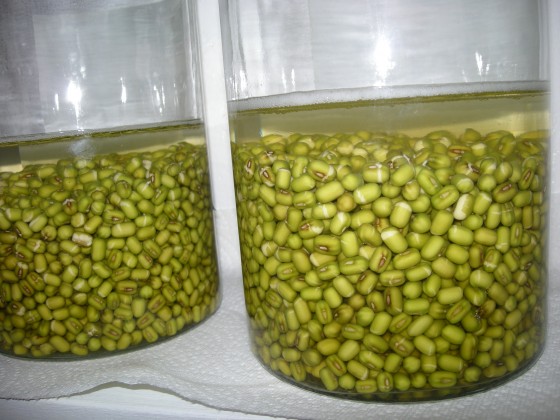Ayurveda Lunch-Honolulu Teacher Training ☆ Mung Beans-

Detoxifying Cleanse-a hint of the soluble and insoluble fibers in mung bean that literally scrape your colon clean. The humble and bland little bean is your passport to enjoy the rich and exotic flavors of India. Mung bean is a versatile legume that absorbs flavors of other spices and herbs, retaining their purity and vibrancy. They offer a mesmerizing bellyfull of contentment; a bowlful of satisfaction that could become addictive. While it fills your belly you'll also enjoy many health and nutritional benefits. Mung beans and kitchari have a long history of food and medicinal use throughout Asia and have now made their way into kitchens here in the United States and are gaining widespread popularity. Cleansing Are you feeling lethargic and tired? Do you feel bloated or have irregular bowel movements? Do you often see a thick white coating on your tongue? These are signs you may need a detoxifying cleanse with mung beans. The pastiness of mung bean is your cue to its cleansing action - a hint of the soluble and insoluble fibers in mung bean that literally scrape your colon clean. But it's not the only sign of mung's cleansing properties. Place a teaspoon of uncooked mung dal on your tongue. Within a minute, you will notice a dry, rough sensation in your mouth. This sensation is called astringent taste in Ayurveda. The astringent taste of mung bean helps tone your digestive organs. Along with fiber, astringency helps to purge mucus from the bowels, rooting out toxins and parasites that may be lodged in your gut. Want to experience the cleansing and revitalizing properties of mung bean directly? Try kitchari. Simple and easy to make at home, kitchari features rice, a legume, ghee or oil, salt and spices. You may also add greens such as kale, vegetables like potatoes and squashes, or garnish with cilantro and coconut flakes. Popular kitchari spices include ginger, cumin, cayenne, cinnamon, fennel and asafoetida. To cook kitchari, boil the mung beans until soft. Fry the spices gently in ghee or oil. Then add all the ingredients to the mung bean broth, simmering until the rice is tender. Add mung beans into your regular meal plan by replacing lunch and dinner with a hearty serving of mung bean kitchari once a week. Monday's are often the most convenient day for a kitchari fast, as you may be more motivated after a weekend of rich and heavy foods. You will benefit from increased energy, improved metabolism, regular and healthy bowel movements and reduced signs of constipation, as well as an overall boost in your immunity and general feeling of wellbeing and vitality. For enhanced cleansing, you can extend your kitchari fast (also called kitchari mono-diet) for 1-10 days. Time any type of cleanse for when you're not too busy or distracted and keep a thermos handy so you can enjoy your kitchari at work. During your cleanse, minimize or eliminate rigorous exercise, refined sugars, alcohol, and cold beverages. Replace rigorous exercise with walking or yoga, and replace beverages with warm water and / or herbal teas.
Masumi Muramatsu
Honolulu, HI, U.S.A
Posted Date : 05-11-2015
Credited to:
Website: http://www.joyfulbelly.com/Ayurveda/ingredient/Mung-Bean/32